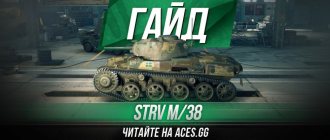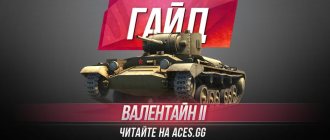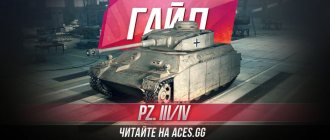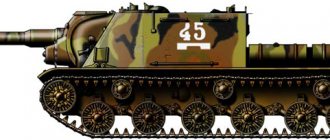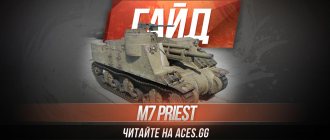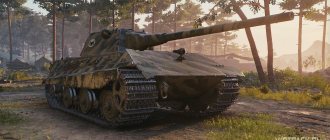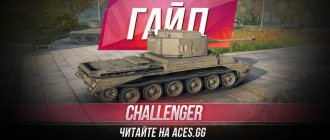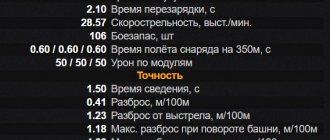Good day and welcome to aces.gg! Today the topic of our conversation will be a completely new and unique vehicle, a Swedish tank destroyer of the tenth level and now in front of you Strv 103B guide
.
This device, like the two previous self-propelled guns in the Swedish development branch, differs from all current equipment not only in appearance or its parameters, but in completely new mechanics, thanks to its hydropneumatic suspension and more. Now we will talk about the features of this tank, we will analyze the Strv 103B characteristics
and make a first impression of this car.
Features Strv 103B
As already mentioned, this tank destroyer has a unique gameplay due to a set of technical features that we have not encountered before in World of Tanks, and the first thing worth talking about is the siege and marching modes.
So, the game is on a tank destroyer Strv 103B
involves the use of two separate modes, designed for different actions: 1. Walking - in it you start the battle and in it we have excellent mobility.
This mode was created purely for movement, because in it we have an excellent maximum speed of 50 km/h forward and 45 km/h back, very decent dynamics, but maneuverability leaves much to be desired. At the same time, it is possible to fire in this mode, but it will be extremely ineffective due to reduced accuracy, longer reload time of the gun, and the inability to use the hydropneumatic suspension to change your air guns. 2. Siege - in this mode, the Swedish tank destroyer Strv 103B
becomes practically motionless, our maximum speed when moving forward and backward is only 10 km/h, but the same speed of rotation of the body remains, because this is the only ability of this unit to be aimed in the horizontal sector. Changing modes is done by pressing the “X” button and the main reason why “siege” was invented is to cause damage. The fact is that in siege mode we have phenomenal accuracy, a very serious rate of fire, the aiming circle does not spread even when the hull turns, but more importantly, the hydropneumatic suspension is activated, thanks to which you can adjust the vertical guidance angle.
Hydropneumatic suspension
We have already mentioned several times such a complex phrase as hydropneumatic suspension, but what is it?
In fact, everything here is quite simple, you will figure it out after 2-3 fights. The fact is that the Strv 103B World of Tanks
the gun is a stationary element, it is always located in a horizontal position and cannot independently change the angles of vertical and horizontal aiming. All movements in the vertical plane are carried out by moving the body.
It works as follows - in order for the suspension to be activated, you definitely need to switch to the siege mode of your Strv 103B tank destroyer
. Once the transformation is complete, you will be able to change the position of your tank by raising or lowering the muzzle, as shown in the screenshot above.
However, this is not all the possibilities, because the hydropneumatic suspension Strv 103B WoT
takes a direct part in your survival, but we’ll talk about this later, when we deal with armor.
Tank S takes shape
The development of the Strv S was carried out by Bofors, not Landsverk, although the latter took part in the work. General management was provided by KATF and Sven Berge personally. The company presented its first conceptual developments to the Armaments Department in October 1958.
The most interesting element of the design at the early stage of development turned out to be the actual weapons. Customers made a remark to Bofors that the 105-mm gun that the company was developing for the promising KRV tank had insufficient armor penetration. The company took action by developing a gun with a longer barrel. Thanks to this, the initial speed of the armor-piercing projectile reached 1100 m/s, and the sub-caliber projectile - 1455 m/s. By the way, the Swedes still believed that the gun of a turret tank should be equipped with an automatic loader.
Bofors presented the first preliminary design of the Strv S in early August 1959. Already from this it became clear that the design of the tank would be extraordinary. As in Sven Berge's first sketches, the tank had a wedge-shaped hull. The engine and transmission compartment was located in the bow, and from the very beginning the Swedes decided that the power plant should be combined. It included a diesel engine and a gas turbine.
The Strv S's armament also looked unusual. The gun, fixedly mounted in the hull, was equipped with an automatic loader, which was fed from several magazines in the rear of the tank. According to the requirements, the ammunition was estimated at 50 rounds. The main problem at the design stage was the gun itself: it was very long, as much as 7 meters
Sven Berge urgently began to design a special fence that would protect the gun from collisions with the ground and various obstacles.
After discussing the project in August 1959, the designers decided that it was necessary to abandon the gun, which was too long. The simplest replacement turned out to be the English 105-mm L7 cannon. However, the Swedes decided not to use it in its original form, but launched the development of their own cannon based on the English gun.
There were also many comments about the tank as a whole. As a result, the tank was heavily redesigned. In August 1960, a redesigned version of the car was presented. Its combat weight increased by 4 tons. The body “stretched” almost a meter in length and 15 centimeters in height. Due to this, the Swedes were able to reduce the overhang of the barrel beyond the dimensions of the tank to 2 meters. But concerns remained about the high probability of damage to the barrel due to obstacles, so the engineers provided for the installation of a special protective fence. The number of course machine guns increased to four (!); engineers were going to install them on the upper frontal sheet.
The development of the Strv S did not stop there. At the same time, the Swedes began to design a hydropneumatic suspension, more compact and simpler than the old one. By the end of 1960, the appearance of the Strv S had finally taken shape. The tests dispelled fears that the tank would hit obstacles with its barrel. The built full-size model no longer had a protective fence. It was in this form that the tank was approved for construction.
According to the contract that KATF entered into with Bofors in November 1959, the development of the Strv S involved the production of two prototypes. Both were supposed to be built in 1961. The budget for the turretless tank program was 15 million Swedish kronor. The amount is very impressive, but it is worth keeping in mind that this money cannot be compared with prices during the war period. Less than two dozen English Centurions cost about the same amount to Sweden.
TTX Strv 103B
Now it’s time to talk about the general parameters of this unit and the first thing you should know is that our self-propelled anti-tank gun has a modest margin of safety even by the standards of most of its classmates, as well as a limited basic visibility of 360 meters, which will need to be raised.
If we consider the Strv 103B TTX
reservations, then in raw numbers everything looks very weak, it seems that absolutely everyone will get through us. In reality, everything is completely different and here the hydropneumatic suspension comes into play again.
Not only is the Strv 103B tank
has a teardrop shape, this factor can be used to your advantage.
Depending on the position you take, you can position yourself in such a way that the angle of your armor relative to the enemy is so great that it will be absolutely impossible to penetrate you (as shown in the screenshot above). In other words, if everything is done correctly, we can only be damaged by a landmine. In addition, in the frontal projection from above, the Strv 103B
has a 10-mm anti-cumulative screen in the form of a special mesh and a similar screen covers the NLD, only it looks different (like a bucket or step).
A huge advantage in terms of survivability will be the small dimensions of our self-propelled gun, its very low silhouette and the ability to become so that it almost completely merges with the landscape of the map. So that you understand, the Swedish tank destroyer Strv 103B World of Tanks
not visible at a distance of 70 meters if she stands behind a bush in siege mode and with an active camouflage network.
As for mobility, we have already talked about it. In traveling mode, this machine has an amazing maximum speed when moving forward and backward, we pick up speed very quickly due to the excellent dynamics and only maneuverability of the Strv 103B WoT
weak.
Serial production and modifications
Deliveries of the basic model Strv-103A began in 1966. A total of 80 such vehicles were built. In 1969–1971 The army received 210 Strv-103B tanks. They differed from the first model by a more powerful Caterpillar 553 gas turbine, the replacement of a heavy machine gun with a regular one, and also somewhat stronger armor. Additionally, the Strv103B tanks received a frontal anti-cumulative shield - a grille made of armored steel, capable of withstanding up to four hits from RPG grenades. It is interesting that this device was considered secret and was not installed on tanks in peacetime - the screens were stored in warehouses and were to be installed only when mobilization was announced.
Movement Strv-103 afloat
In 1986–1989 Strv-103В tanks underwent a radical modernization, receiving the designation Strv-103С. During its course, the K60 diesel engine was replaced by the American Detroit Diesel 6V-53T engine with a power of 240 hp. With. The modified gearbox now had three forward speeds and two reverse speeds. The smaller dimensions of the new diesel engine made it possible to increase the fuel supply. In addition, new radiators of the cooling system, muffler and generator were installed on the car. Nine fuel cans with a capacity of 22 liters each were attached to each side of the tank as original anti-cumulative screens. The capacity of the mounted feed tanks was also increased. Protection of the frontal lower part of the hull has been strengthened by equipping each vehicle with a bulldozer blade (previously only one tank per platoon had such equipment).
Strv-103 tanks interacted with motorized infantry on Pbv-302 armored personnel carriers
The Strv-103С tank received a new fire control system with a digital ballistic computer, as well as night vision devices. The gun's ammunition included a shot with an Israeli-developed M-111 sub-caliber armor-piercing projectile. A double-barreled 71-mm Liran grenade launcher was mounted at the rear of the hull for firing illumination ammunition. As a result of all the changes made, the weight of the tank increased from 39.7 to 42.5 tons.
In 1992, Strv-103С tanks received components for fastening dynamic armor in the frontal part of the hull, as well as a filter-ventilation unit with pressurized air for the crew compartment.
The last attempt to modernize a turretless tank was made in the mid-1990s, when the Strv-103D variant was proposed. The ballistic computer installed on it determined the firing data within milliseconds and could automatically carry out the “vertical” installation of the tank on a controlled suspension, necessary for an aimed shot. The observation devices were modified, mounted armor was added on the sides and in the stern, and the thickness of the bottom armor was increased. However, the military rejected Bofors's offer, purchasing German Leopard 2A4 (160 units) in 1994, and later Leopard 2A5. The new tanks were designated Strv-121 and Strv-122, respectively. In 1997, the Strv-103С tanks were finally withdrawn from service. The only prototype of the Strv-103D ended up in the museum. Several dozen copies of Strv-103C have been distributed to museums in various countries.
gun
The armament of our Swede can rightfully be considered a strong point, but only when the tank goes into siege mode, because it is the tank that was created to cause damage and is what we are talking about now.
So, Strv 103B gun
has a weak alpha strike compared to other PT-10s, but thanks to its excellent rate of fire, which in siege mode is basic at 5.25 seconds, versus 7.45 in marching mode, we are able to inflict approximately 4000 units of damage, the result is very impressive.
There are also no complaints about the armor penetration parameters; standard APs are quite enough to penetrate level ten tanks, and for especially tough targets, the Strv 103B World of Tanks tank destroyer
can carry about 10 gold sub-calibers with him, they won’t be superfluous.
The accuracy in siege mode deserves special praise. Not only is our gun one of the most accurate in the game (2.9 dispersion per 100 meters), we are absolutely independent of stabilization, because the dispersion circle is always minimal both after a shot and after body movement.
With the vertical and horizontal aiming angles, everything is fine again. Strv 103B tank
capable of lowering the muzzle down 11 degrees and raising it by the same amount. We do not have UGNs due to the fact that the gun is stationary, but they are not needed due to the lack of dispersion.
Background
By the early 1950s. Swedish tank forces were armed with pre-war equipment: light tanks m/40 and m/42 (Landsverk L60 of their own design), as well as m/38 and m/41 (licensed Czech TNH-Sv). The issue of updating the tank fleet was very acute - in the context of the flaring up of the Cold War, neutral Sweden had to take care of its safety. Of the two possible options - purchasing tanks abroad (or purchasing a license) or developing a tank on our own - at first the choice was made in favor of the first. The Swedish military, having analyzed the capabilities of the tanks that existed at that time, came to the conclusion that the needs of the country were best met by the British Centurion Mk3. But when in 1951 the Swedish government made a corresponding request to the British, the answer was negative: no deliveries of Centurions abroad were possible until the needs of its own army were met, and this required... from 5 to 15 years! The Scandinavians had no choice but to take on the design on their own - fortunately, the capabilities of the Swedish heavy industry allowed them to count on success.
The design was carried out in secrecy, and the new combat vehicle itself was designated KRV - short for KRANVAGN, i.e. “self-propelled crane”! In parallel, another designation was used - “EMIL project”. The Swedes were developing a well-protected tank, one of the versions of which included armament with a 155-mm smoothbore gun with a barrel length of 40 calibers. The other two weapon options were more traditional - a 105 mm or 120 mm rifled gun with a barrel length of 67 or 40 calibers, respectively. It was envisaged to use an automatic loader similar to that installed on the French light tank AMX-13 - two rotating drums containing part of the ammunition.
In 1951, the main version was adopted with a 120-mm cannon with 32 rounds of ammunition (16 of them were placed in two automatic loader drums). With an estimated weight of only 28 tons, the tank had very powerful armor protection: the thickness of the frontal part of the hull, installed at an angle of 45°, was 150 mm! 8-cylinder boxer air-cooled diesel engine with a power of 550 hp. With. provided a maximum speed of 55 km/h. Other versions of the tank were also being studied, and as a reserve, negotiations began with France regarding the purchase of light AMX-13. However, already in December 1952, the British, under the pressure of the economic crisis, themselves began to beg the Swedes to buy Centurions. Negotiations proceeded very quickly: at the beginning of 1953, a contract was signed for the supply of 80 Centurions Mk3 (with an 83.8 mm gun), and already in April the first batch of such tanks arrived in Sweden. The vehicles were designated Stridsvagn-81 ("Combat Vehicle-81"), or Strv-81 for short, later replaced by Strv-101. And when they later managed to buy 270 Mk10 Centurions with 105-mm guns (Swedish designation Strv-102), the development of a “crane” completely lost its relevance. Note that in the Swedish designation system for tanks and self-propelled guns, the first digit (or two) means the caliber of the gun in centimeters (rounded), and the second, or, accordingly, the third, is the serial number of the tank or self-propelled gun armed with such a weapon. Thus, the hero of our story today, after being put into service, received the designation Strv-103 - the 3rd tank with a 10 cm (105 mm gun).
Advantages and disadvantages
We have before us a completely new understanding of tank destroyers; such equipment has never been seen in the game before, and for this reason it is very important to fully understand all the strengths and weaknesses of the Strv 103B World of Tanks
, because it is based on this knowledge that you will build battle tactics. But please take into account that we will highlight the pros and cons taking into account the use of one or another mode depending on the situation. Pros: •Excellent mobility; •Good damage per minute; •Stunning reduced armor; •Phenomenal camouflage; •Excellent accuracy; •Good armor penetration performance; •Comfortable UVN and UGN. Cons: •Small safety margin; •Poor viewing range; •Small alphastrike; •Weak armor of the sides and roof; •Vulnerable to landmines and artillery.
Turretless tanks in service
Swedish army in peacetime in the 50s - 80s. of the last century did not contain the usual formations (corps, divisions, brigades), consisting only of training and mobilization regiments. Conscripts underwent training and combat training there. In the event of mobilization being announced, wartime formations were deployed on the basis of these regiments - infantry (of two types - conventional and Nordic, intended for operations in the northern regions of the country) and armored brigades. In peacetime, there were 45 training and mobilization regiments, of which seven were armored; in wartime, 19 infantry, five Norland infantry and four armored brigades were deployed.
All main battle tanks were concentrated in the armored brigades; the infantry brigades had only a company of IKV-91 light tanks. According to Swedish military experts, the armored brigade was capable of solving any problems in all types of combat operations. However, the difficult physical and geographical conditions of the country make it difficult to use armored formations in most of the territory. Only the southern regions, where relatively flat terrain prevails, are suitable for operations by armored forces. In addition, it is these areas that are most vulnerable from the sea and can be used by the enemy to land large amphibious assault forces. Therefore, all four armored brigades deployed during mobilization activities were planned to be used in southern Sweden.
The Swedish armored brigade in its deployed form was a fairly large formation with a personnel strength of about 5,700 people. It was based on three armored battalions - essentially ready-made combat groups, equipped not only with tanks, but also with motorized infantry, artillery, and sappers. Organizationally, the battalion included a headquarters, two tank, two motorized infantry companies, a support company and a battery of self-propelled howitzers. A headquarters company of about 150 people. included headquarters, communications and three reconnaissance platoons, tank (140 people) - four tank platoons (three Strv-103 each), motorized infantry and control, motorized infantry (160 people) - three motorized infantry platoons, anti-tank and control. The supply company (200 people) included sapper, repair and evacuation, medical and bridge-laying platoons, as well as control and fuel supply sections. Finally, the artillery battery (40 people) consisted of two fire platoons, a control platoon and a supply section. In total, the battalion was armed with 24 Strv-103 tanks, four 105-mm Ikv-103 self-propelled howitzers (adopted into service in 1956, somewhat reminiscent in layout of the German “Sturmgeschutz” of the Second World War), 40 Pbv-302 armored personnel carriers , eight 90-mm recoilless rifles, 35 84-mm Carl Gustav grenade launchers and other equipment.
Strv-103С - rear view
In addition to the armored battalions, the brigade included:
- headquarters company (about 170 people);
- artillery division (700 people, 12 155-mm towed howitzers FH-77B);
- reconnaissance company (150 people, two reconnaissance platoons on armored personnel carriers, two on cars, an anti-tank platoon);
- anti-tank company (140 people, 12 Tou ATGMs);
- anti-aircraft battery (140 people, 12 20-mm anti-aircraft guns and six RBS-70 MANPADS);
- engineering battalion (400 people; headquarters, pontoon-bridge, engineering and sapper companies);
- supply battalion (about 700 people; headquarters, transport, supply, repair and restoration, medical and sanitary companies, supply of fuels and lubricants).
Fortunately, the Swedes did not have the opportunity to test the effectiveness of the structure and armament of their armored brigades in battle. Therefore, the methods of their application can only be judged by the regulations and instructions, as well as based on the results of the exercises. It was assumed that armored brigades would be directly subordinate to the commanders of military districts, and in some cases, assigned to infantry divisions operating in the main direction. The main purpose of armored brigades was considered to be to strike the enemy in order to defeat his main groups. However, in some cases, for example, when the enemy achieved success as a result of a surprise attack or numerical superiority, they were allowed to be used to conduct deterrent or defensive actions.
Based on the specific conditions of the terrain and the presence of large forests, armored brigades should be used only in close cooperation with infantry units of field troops and local defense troops.
When conducting an offensive, the armored brigade was supposed to operate in the main direction, forming its battle formations in two echelons (two battalions in the first and one in the second). The width of the offensive zone could reach 10 km. Taking into account the difficult terrain and the presence of vast areas of closed terrain, it was recommended in the offensive to make extensive use of unit maneuvers to strike at the enemy’s flank or rear if he had open flanks and did not have time to sufficiently strengthen his defenses.
In defense, an armored brigade, depending on the nature of enemy actions and terrain conditions, could form battle formations in one or two echelons. At the same time, the width of the defense zone was 15–25 km. The defense was, as a rule, focal in nature: brigade units covered the most likely directions of the enemy’s attack, organizing close fire cooperation.
To slow down the pace of enemy advance, inflict losses on him in manpower and military equipment, as well as create conditions for the deployment of its troops, an armored brigade could conduct restraining combat operations on a wide front (up to 35 km). During their course, they occupied defensive lines in advantageous areas of the terrain. As the assigned tasks were completed, the units were planned to withdraw from their occupied lines, organizing ambushes and counterattacks on the flank of the advancing enemy.
Equipment for Strv 103B
It is very important to choose the right additional modules for this unit, because some options simply do not make sense in our case. For example, they are not needed here at all, due to the lack of spread in siege mode, etc. Thus, for Strv 103B equipment
is selected as follows: 1. – we increase our rate of fire, which will have a beneficial effect on damage per minute and will make us a more dangerous enemy. 2. – this module will completely solve all problems with visibility, moreover, it is especially relevant for a certain style of play, which is suitable for this tank destroyer. 3. – goes well with the second point and will make us a real invisible person.
If you wish, you can replace the third paragraph with . The fact is that our camouflage is already excellent, and a 5% boost in parameters has never been superfluous, because with it we get even greater DPM.
Skills for the crew of Strv 103-0
Not a single crew can do without additional skills, and their correct selection will ensure proper success during the battle. It should be noted that in this combat vehicle the crew consists of only three tankers, and not four, plus all the advantages of the siege mode must be added here, so the following skills are required:
• Commander – Combat Brotherhood, Sixth Sense, Camouflage, Repair; • Driver – Brotherhood, Camouflage, Virtuoso, Repair; • Radio operator – Combat brotherhood, Camouflage, Radio interception, Repair.
The equipment in the Strv 103-0 vehicle will be standard, as elsewhere:
• small first aid kit – disposable, heals one tanker, manually activated; • small repair kit – disposable, repairs one damaged module, activated manually; • manual fire extinguisher – extinguishes the flame in a car with manual activation, valid once.
If funds are available, the player can purchase a large first aid kit, an automatic fire extinguisher and a large repair kit. By the way, the fire extinguisher can be replaced with Coffee and Pastries, which will increase the crew’s skills by 10%.
Tactics for playing on Strv 103B
Due to the fact that the vehicle in our hands is very unusual and unique, the gameplay on it will be special and in addition to using the advantages of your tank, you need to be creative.
We start the battle in marching mode with excellent mobility, so on the Strv 103B tactics
conducting combat initially involves occupying an advantageous position where it will be difficult to detect you, it will be difficult for enemy artillery to shoot at you, and at the same time it will open up good opportunities for causing damage.
Ideally, you need to position yourself on the second or even third line, using the terrain. In this case, having arrived at the treasured place, the Strv 103B tank
can immediately activate the siege mode, take a position and begin to implement its DPM on the allied light.
We're good at long-range fire thanks to excellent accuracy and good penetration, but even if the enemy gets close and spots us, it's not a cause for concern. Use your hydropneumatic suspension and position yourself so that your Strv 103B World of Tanks
acquired the most acute angle in relation to the opponent. If it is not possible to fire in this position, you can fire a shot and increase your aim again.
The main problem when entering close combat is that they may shoot down our harp, then, due to the complete lack of attack control, we will have no chance to fight back on our own. However, almost all tank destroyers in our game and the Swedish tank Strv 103B WoT
not an exception.
Try never to let anyone on board and try to analyze the battle situation, because if the flank is broken through and superior enemy forces are approaching, you need to switch to marching mode in advance, otherwise later you will simply not be allowed to escape alive.
And lastly, in siege mode, the Strv 103B tank destroyer
is very vulnerable to enemy artillery, so as soon as the light comes on overhead and you are in an unprotected place, it is better to transform and change position as quickly as possible.
Otherwise, we have a really very creative machine in our hands. It requires a lot of gaming experience and getting used to, but in the right hands this device is really capable of a lot.
